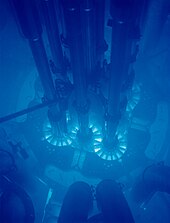Pavel Cherenkov
You can help expand this article with text translated from the corresponding article in Russian. (September 2024) Click [show] for important translation instructions.
|
This article needs additional citations for verification. (September 2016) |
Pavel Cherenkov | |
|---|---|
| Павел Черенков | |
 Cherenkov in 1958 | |
| Born | Pavel Alekseyevich Cherenkov July 28, 1904 |
| Died | January 6, 1990 (aged 85) |
| Resting place | Novodevichy Cemetery, Moscow |
| Nationality | Russian |
| Alma mater | Voronezh State University |
| Known for | Characterizing Cherenkov radiation |
| Awards | Nobel Prize in Physics (1958) |
| Scientific career | |
| Fields | Nuclear physics |
| Institutions | Lebedev Physical Institute |
| Doctoral advisor | Sergey Vavilov |
Pavel Alekseyevich Cherenkov (Russian: Па́вел Алексе́евич Черенко́в [ˈpavʲɪl ɐlʲɪkˈsʲe(j)ɪvʲɪtɕ tɕɪrʲɪnˈkof]; July 28, 1904 – January 6, 1990) was a Soviet physicist who shared the Nobel Prize in physics in 1958 with Ilya Frank and Igor Tamm for the discovery of Cherenkov radiation, made in 1934.[1]
Biography
[edit]Cherenkov was born in 1904 to Alexey Cherenkov and Mariya Cherenkova in the small village of Novaya Chigla. This town is in present-day Voronezh Oblast, Russia.
In 1928, he graduated from the Department of Physics and Mathematics of Voronezh State University. In 1930, he took a post as a senior researcher in the Lebedev Physical Institute. That same year he married Maria Putintseva, daughter of A.M. Putintsev, a Professor of Russian Literature. They had a son, Alexey, and a daughter, Yelena.
Cherenkov was promoted to section leader, and in 1940 was awarded the degree of Doctor of Physico-Mathematical Sciences. In 1953, he was confirmed as Professor of Experimental Physics. Starting in 1959, he headed the institute's photo-meson processes laboratory. He remained a professor for fourteen years. In 1970, he became Academician of the USSR Academy of Sciences.
Cherenkov died in Moscow on January 6, 1990, and was buried in Novodevichy Cemetery.
Discoveries in physics
[edit]
In 1934, while working under S. I. Vavilov, Cherenkov observed the emission of blue light from a bottle of water subjected to radioactive bombardment. This phenomenon, associated with charged subatomic particles moving at velocities greater than the phase velocity of light, proved to be of great importance in subsequent experimental work in nuclear physics, and for the study of cosmic rays. Eponymously, it was dubbed the Cherenkov effect, as was the Cherenkov detector, which has become a standard piece of equipment in particle-physics research for observing the existence and velocity of high-speed particles. Such a device was installed in Sputnik 3.
Pavel Cherenkov also shared in the development and construction of electron accelerators and in the investigation of photo-nuclear and photo-meson reactions.
Awards and honours
[edit]Cherenkov was awarded two Stalin Prizes, the first in 1946, sharing the honor with Vavilov, Frank and Tamm, and another in 1952. He was also awarded the USSR State Prize in 1977. In 1958, he was awarded the Nobel Prize in Physics for the discovery of the Cherenkov effect.[2] He was also awarded the Soviet Union's Hero of Socialist Labour title in 1984. Cherenkov was a member of the Communist Party of the Soviet Union since 1946.
In popular culture
[edit]The novel Ghost Fleet makes the claim that many believe the Star Trek character Pavel Chekov is named after Pavel Cherenkov.[3]
In Starship Troopers spaceships travel faster than light using Cherenkov Drive.
References
[edit]- ^ Chudakov, Alexander E. (December 1992). "Obituary: Pavel Alexeyevich Cherenkov". Physics Today. 45 (12): 106–107. Bibcode:1992PhT....45l.106C. doi:10.1063/1.2809928.
- ^ "The Nobel Prize in Physics 1958".
- ^ Singer, P.W.; Cole, August (2015). Ghost Fleet. HarperCollins. p. 21. ISBN 9780544145979 – via Google Books.
External links
[edit] Media related to Pavel Cherenkov at Wikimedia Commons
Media related to Pavel Cherenkov at Wikimedia Commons- Cherenkov's photo – from the Russian Academy of Sciences
- Pavel Cherenkov on Nobelprize.org including his Nobel Lecture, December 11, 1958 Radiation of Particles Moving at a Velocity Exceeding That of Light, and Some of the Possibilities for Their Use in Experimental Physics
- 1904 births
- 1990 deaths
- Burials at Novodevichy Cemetery
- Experimental physicists
- Heroes of Socialist Labour
- Recipients of the USSR State Prize
- Full Members of the USSR Academy of Sciences
- Nobel laureates in Physics
- Particle physicists
- Soviet inventors
- Soviet Nobel laureates
- Soviet physicists
- Recipients of the Stalin Prize
- Communist Party of the Soviet Union members
- Voronezh State University alumni
- Academic staff of Moscow Power Engineering Institute
- Foreign associates of the National Academy of Sciences
- Russian scientists

